Friday, May 22. 2009
AUTO. SUEÑO Y MATERIA - Cars and landscapes
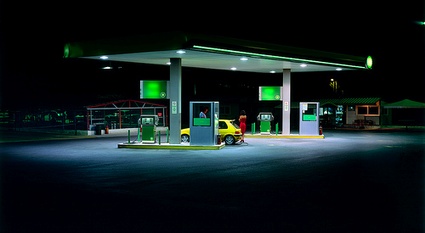
Panos Kokkinias, Gas Station, 2003
AUTO. SUEÑO Y MATERIA [AUTO. DREAM AND MATERIAL], the new exhibition at Laboral Centro de Arte y Creación Industrial analyzes contemporary car culture through the lens of some 100 artworks.
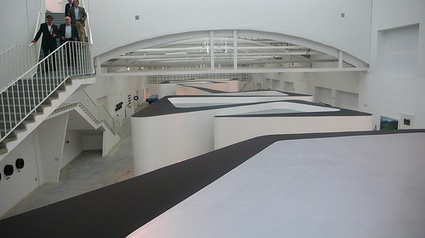
Lovely interior architecture by longo + roldán arquitectos
What an interesting moment to organize an exhibition on cars. Reading online newspaper over the past few months, i had the feeling that an era is closing. Buying a new car is suddenly not as desirable as it used to be: consumers have a new or stronger eco-conscience but most of all, they've been hit by the financial crisis. Sales of vehicles are hitting rock bottom. Governments are discussing or unveiling rescue packages. Jobs in the car industry are threatened. Car companies from all over the world are forced to resort to creative marketing strategies to seduce consumers: major manufacturers are offering hefty discounts while Hyundai is allowing customers to return their new cars if they lose their jobs.
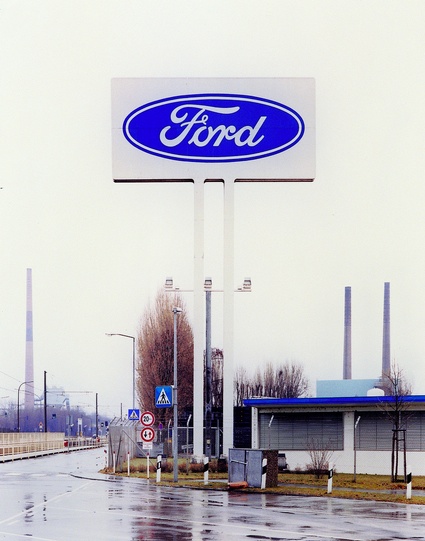
Frank Breuer, Untitled (624 Köln), 1996
Cars have shaped the 20th century probably more than any other product of technology. Ever since Carl Benz created the first "horseless carriage" (1885), the automobile has had a deep impact on almost every single aspect of our life: landscapes, architecture, geo-political relationships (necessity to gain control of the areas that produce its fuel), social and labour movements, even the air we breathe. Cars are also objects of desire, ambitions and dreams. They symbolize independence, power, they've starred in movies and their commercials feature the sexiest women around.
Referring in particular to the Citroën DS (the only car that has ever managed to get my attention), Roland Barthes famously said: "I think that cars today are almost the exact equivalent of the great Gothic cathedrals: I mean the supreme creation of an era, conceived with passion by unknown artists, and consumed in image if not in usage by a whole population which appropriates them as a purely magical object."
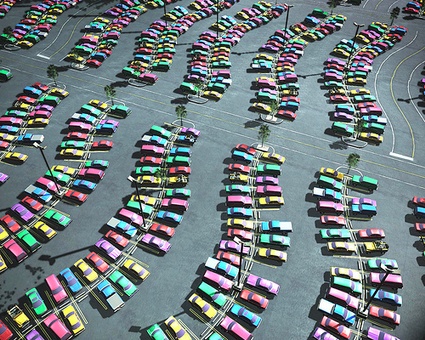
Sven Pählsson, Sprawlville or Life at the Highway Exit Ramp, 2002
AUTO. SUEÑO Y MATERIA keeps a balance between the dark sides and the most attractive aspects of car culture: mobility, speed, power, sex, damages to the environment, alteration of the landscape, energy waste, traffic, etc. Most of the pieces on show embraces several themes at a time. I found the exhibition fascinating and timely but a bit encyclopedic. I'll try and give you a tour in a couple of posts. This one is going to focus on the imprint that car culture has left on rural and urban landscapes: fast highways of course but also rural roads built on purpose for tourists to leisurely enjoy picturesque landscapes, sidewalks for the un-motorized, signage to control traffic, architecture that had to be adapted or created from scratch in order to enable driver to refuel their car, simply park it or lure them into spending the night by the road, etc.
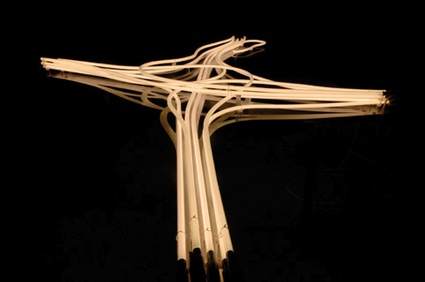
Koen Wastijn, Traffic of Traffic, 2008
Koen Wastijn is a sculpture made of neon tubes bent and twisted in the shape of Brussel's highway interchange which, for the artist, is "the most beautiful Belgian sculpture."
The luminous characteristics of the sculpture remind Belgians (like me) of that tale our parents like to repeat us over and over again: Belgian highways are so brightly lit that they can be seen from space. The sculpture evokes also the number of time we've been stuck in jam right into that knot. The car, this icon of speed and movement becomes a box in which we curse and pray till the traffic finally resumes its fluid course.
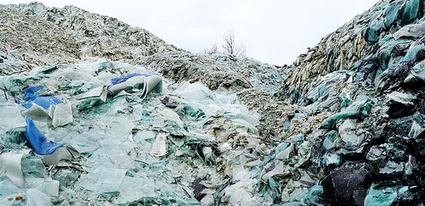
Eric Aupol's photos of a glass recycling center in Picardie, reminiscent of Edward Burtynsky's Oxford Tire Pile (also present in the exhibition), portray waste a an inevitable but also highly aesthetic corollary of industry and consumerism. Its accumulation designs "new" landscapes. Piled up broken bits of glass are paralleled with geological formations.
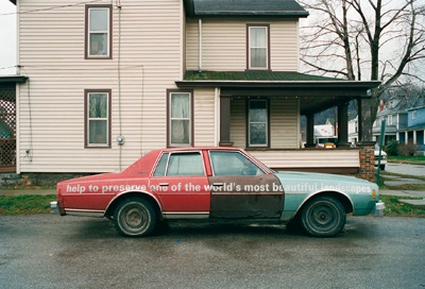
Alain Bublex, Achetez de l'acier, 2006
Alain Bublex tackles this idea of new landscape with the photo Achetez de l'acier (Buy Steel) is a photograph shot with what looks like a Düsseldorf-style detachment. A battered American car from the 1970s is parked in front of a wooden house on a side street in some small industrial
town, the weather is glum. On its side, the car bears the inscription: "help to preserve one of the world's most beautiful landscapes."
The artist explained that his photo highlights the "false paradox" between the issue of preserving the landscape (which is usually restricted to nature) and that of the disappearance of industrial landscapes. Buy Steel and we'll have smoking factories and dramatic landscapes! This solution is in opposition with the one of our time, which tries to convert old factories into cultural centres.
Moreover, the shooting distance from the subject and the lighting patterns reinforces, even more than the sense of our voyeuristic witnessing of a story, the certainty that we are brought in contact with the projection of a mystical dynamic. In this way Kokkinias manages to transform the familiar into an unexplored, remote place, at the same time turning his stories into fantasies which may become true at any moment.
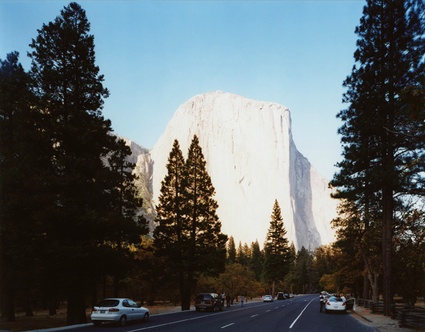
Thomas Struth, El Capitan, Yosemite National Park, 1999
El Capitan, an imposing rocky granite mountain located in Yosemite National Park, has been photographed time and time again by hordes of tourists and masters of photography. Thomas Struth portrayed the rock formation from the road, the place that, as we see in the photograph, is also the place where many visitors stop their car and look at the mountain. Unlike most photographers, Struth chooses not to obliterate the road and the cars. They might not seem to belong to the pristine beauty of nature but they enabled tourists to get a fast and easy access to it.
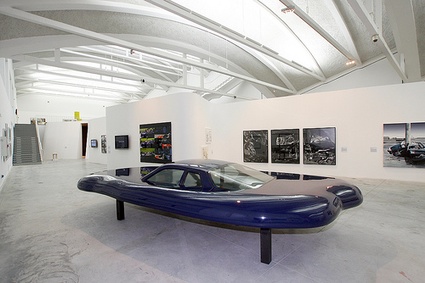
Exhibition view (photo Enrique G. Cardenas)
More soon...
The exhibition is on view until September 21, 2009 at a href="http://www.laboralcentrodearte.org/">Laboral Centro de Arte y Creación Industrial in Gijon, Spain.
-----
Via WMMNA
Related Links:
Personal comment:
Un autre post sur l'exposition à Laboral. Les images de station d'essence: toujours aussi fascinantes, les paysages en 3d désertés des sociétés occidentales de Pählsson aussi, etc.
data.gov is Live

Twitter is currently echoing the excitement of open data advocates and data geeks alike, due the release of data.gov, an open and free web repository that aims to provide public access to US Federal Government datasets. Or, in official terms: "The purpose of Data.gov is to increase public access to high value, machine readable datasets generated by the Executive Branch of the Federal Government". However, while this means that the data has finally become freely available, it is certainly not yet accessible or even understandable for lay people. The huge homepage banner "Discover. Participate. Engage." therefore seems a bit hollow, as long as there are no interfaces and visualizations to really allow the general audience to explore the knowledge and insights hidden within. We are therefore all curious when and what online data visualizations will soon exploit this opportunity to bring data closer to people!
Hence Sunlight Labs has just launched, in partnership with Google, O'Reilly Media and TechWeb, a contest called "Apps for America", including $25,000 in awards." The contest submissions will also show the creativity of developers in designing compelling applications that provide easy access and understanding for the public, while also showing how open data can save the government tens of millions of dollars by engaging the development community in application development at far cheaper rates than traditional government contractors."
If you are interested in data.gov, you might also like USgoXML.com, another index of web services and XML data sources that have been provided by the US government.
You might also want to know that today was also the launch of the Open Government Initiative website.
More information and (mixed) reviews about the data.gov website can be found at Huffington Post, Wired and ReadWriteWeb, and probably at many more news outlets very soon.
European Union, what are you waiting for?
-----
Personal comment:
Mouvement intéressant réalisé par l'administration fédérale américaine: rendre les données (certaines données...) collectées par l'Etat accessible au public, mais surtout exploitable par d'autres applications ("machine readable").
C'est une question intéressante relative à la propriété des données: privées ou publiques (et puis aussi: conservées ou effacées, analysées ou "passives", centralisée ou non, mises en relation ou non, "mined" ou pas, etc.)
Wednesday, May 20. 2009
Bruce Sterling's The Caryatids: A Review
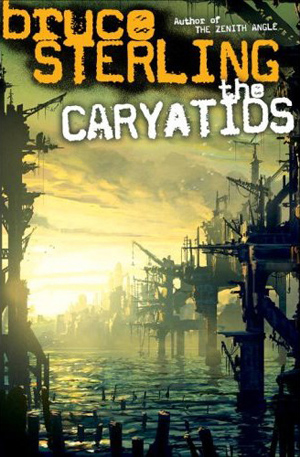 Pity those science fiction writers who adapt too slowly: many labor with tools invented for a 1950s version of the genre that no longer makes sense; they're still dreaming heroic rocketcar dreams when the future is scrambling towards carbon-free distributed car-sharing for Indian slums. Nothing decays faster than an old future, and most writers are lucky to find one unique vision of how things might be, much less find a new one when their first wears out.
Pity those science fiction writers who adapt too slowly: many labor with tools invented for a 1950s version of the genre that no longer makes sense; they're still dreaming heroic rocketcar dreams when the future is scrambling towards carbon-free distributed car-sharing for Indian slums. Nothing decays faster than an old future, and most writers are lucky to find one unique vision of how things might be, much less find a new one when their first wears out.
Bruce Sterling, though, is not most writers. He seems to take joy in churning through not just new scenarios for his ideas, but whole new futures about which to think. It's a pretty wild thing to be on top of your game for 30 years, especially when your game is staying tapped into the zeitgeist. (He is also a good friend of this site, Ally #1 as we call him, having run the Viridian list which was one of the inspirations for our founding, and having written the introduction to our first book.)
Of course, Bruce's secret is that, like all good science fiction writers, futurists and strategy gurus, he isn't predicting the future, he's predicting the present. He's using dramatic extrapolations of hidden forces at work today to build a future that magnifies those forces into ideas we can wrestle with. So it should perhaps come as no surprise that Bruce's latest novel The Caryatids pumps some very powerful forces up into cinematic size -- forces that most of us are just still beginning to understand.
The basic plot of The Caryatids doesn't twist too much: seven test-tube siblings, born to a renegade Serbian scientist, are scattered to the winds and struggle to find meaning and purpose in a world that, in 2060, has plunged deep into crisis. That crisis is barely kept from becoming an apocalypse by three competing global power blocs -- the networked, emergent Acquis, the wired, best-practicing Dispensation, and the last nation-state, China -- and the sisters line up on opposite sides. Mayhem arrives as expected, including pop-stardom empire-building, Antarctic terraforming, archaeological microbiology, Chinese bubble ecospheres and desert firefights.
That's all well and good. But where Bruce shines here is in tapping directly into two of the largest emerging trends on our planet, which remain nonetheless obscure to most people: what we might call the atmospheric singularity and the social singularity. The future here, takes place on a planet that has erupted into ecological chaos (of a sort that might be ripped fresh from the pages of the latest panicked scientific papers on climate, oceans and biodiversity -- the Earth, seen from space, reveals "its tainted skies, its spreading deserts, and its long romantic plumes of burning forests."), among people who have swallowed a whole new generation of social technologies, and grown new cultures to match.
As such, one of the most riveting aspects of this terrific story is, oddly enough, the competition between completely different sets of social responses to a global ecological crisis. This is disaster-recovery fiction, and it rocks:
"The Acquis were global revolutionaries. They got results in the world. They did some strange things, yes -- but they never stopped trying. ...The wounded island was healing before their eyes. Innovation was coming thick and fast, amazing insights, new services, new techniques. Transformations were bursting from her little island that were fit to transform the world."
or
"Order, unlike war, required unglamorous skills such as political savvy, business sense, and rugged logistics. Restoring order required a crisp, succinct articulation of the big picture and why one's efforts mattered in that regard. It required a tremendous knowledge of details. It needed the patience to build a long-lasting, big-scale enterprise that would not collpase instantly from guerilla attacks. And it needed a cold-blooded ability to make firm choices among disgusting alternatives."
Much of the book is about how people in the worst of situations can connect to something hopeful, something worth striving for, some sort of legacy to give themselves over to. It's a Mother Courage sort of future, but one with technological lightning in its fists and a black sense of humor ("What's small, dark and knocking at the door? ...The future of humanity.").
The Caryatids is my favorite of Bruce's novels since Holy Fire, and frankly one of the best science fiction books I've read in years. It's a book redolent with not only the future, but the concerns of a particular kind of future that is very much of interest to those of us engaged with worldchanging work.
"Los Angeles was a crowded, polyglot mess of a place, trapped between a killer desert and a rising ocean. The city of Los Angeles had blown more climate-wrecking fumes out of its tailpipes than most nations. If there were any justice in the global mayhem of Extinction 6.0, Los Angeles should have been the first place to die: the first city in the world to drown, convulse, starve, riot, black out, and burn right to the ground. Yet there was no justice in the climate crisis. Not one bit of justice. The climate crisis was not concerned with justice: it was about poverty, stench, hunger, floods, fires, thirst, plague and riots. So, although Los Angeles did burn in many places -- Los Angeles had always burned, in many places -- Los Angeles grew much faster than it burned. If this tormented world had a world capital, this was it."
Catastrophe is not the end. Unless you are a monster, the future we've inherited will break your heart. But broken hearts can be mended; life goes on, and when it does, a fierce beauty is sometimes born. The world, when all is said, is always remade by broken people who refuse hopelessness, who refuse to be overcome with sorrow, who refuse to pass on that which broke them.
As we come to grips with the awful fact that we are already committing ourselves to centuries of crisis, loss and burning, we can hew close to the knowledge that while disaster is our inheritance, transcendence can yet still be our legacy. We are all Caryatids now, and we can all dare to hope for the best.
Via WorldChanging
Wednesday, May 13. 2009
One Giant Leap for Twitterkind; Mike Massimino Tweets from Space
 It may not be a moon landing, or a giant leap for mankind, but the first human tweet from space has just made its way over the microblogging platform to Earth. Due to the extraordinary nature of the tweet, this very first one is likely to go down in the annals of Twitter history.
It may not be a moon landing, or a giant leap for mankind, but the first human tweet from space has just made its way over the microblogging platform to Earth. Due to the extraordinary nature of the tweet, this very first one is likely to go down in the annals of Twitter history.
The tweet in question comes courtesy of NASA’s Mike Massimino, a.k.a Astro_Mike, whose status update reads, “From orbit: Launch was awesome!! I am feeling great, working hard, & enjoying the magnificent views, the adventure of a lifetime has begun!”
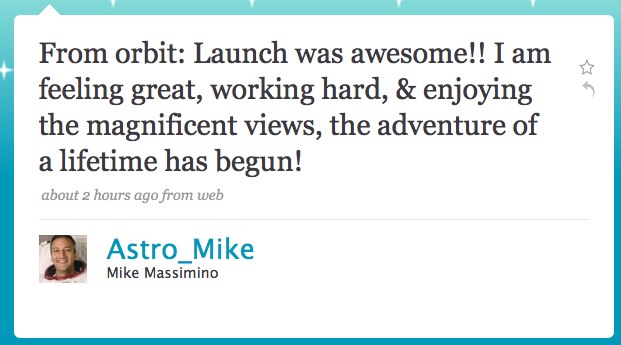
Astro_Mike is part of a seven person crew that left Cape Canaveral on a final maintenance mission to keep the Hubble Space Telescope in service until 2014. With the blessing of NASA, Massimino’s tweets will serve to enlighten his 234,240 followers and add a layer of transparency that we’ve yet to behold.
Sure, we had to expect that Twitter savvy NASA would eventually use their 140 characters to take us outside the confines of Earth, but now that there’s a Twitter space mission in progress, we’re anxious to follow along and see what Astro_Mike tweets next. Who knows, maybe we’ll even get a Twitpic or two?
See also: 10 Most Extraordinary Twitter Updates
-----
Via Mashable
Personal comment:
It's a small tweet for man, but a big tweet for manking?
Dans un temps pas si éloigné, nous suivions tous ça à la télévision... signe que les médias changent. A quand le premier spam de l'espace!? ;)
Tuesday, May 12. 2009
New City Brights (SFGate) post on Twitter Literacy
My latest post on SFGate, Twitter Literacy (I refuse to make up a Twittery name for it) builds on previous Smart Mobs blog posts about “Why I’m hooked on Twitter” and “Tuning and Feeding: My Best Practices for Getting The Most Out of Twitter”
Post-Oprah and apres-Ashton, Twittermania is definitely sliding down the backlash slope of the hype cycle. It’s not just the predictable wave of naysaying after the predictable waves of sliced-breadism and bandwagon-chasing. We’re beginning to see some data. Nielsen, the same people who do TV ratings, recently noted that more than 60% of new Twitter users fail to return the following month. To me, this represents a perfect example of a media literacy issue: Twitter is one of a growing breed of part-technological, part-social communication media that require some skills to use productively. Sure, Twitter is banal and trivial, full of self-promotion and outright spam. So is the Internet. The difference between seeing Twitter as a waste of time or as a powerful new community amplifier depends entirely on how you look at it - on knowing how to look at it.
-----
Via Smart Mobs
Related Links:
Personal comment:
Un petit commentaire d'Howard Rheingold sur Twitter et le début du post "boom/hype".
fabric | rblg
This blog is the survey website of fabric | ch - studio for architecture, interaction and research.
We curate and reblog articles, researches, writings, exhibitions and projects that we notice and find interesting during our everyday practice and readings.
Most articles concern the intertwined fields of architecture, territory, art, interaction design, thinking and science. From time to time, we also publish documentation about our own work and research, immersed among these related resources and inspirations.
This website is used by fabric | ch as archive, references and resources. It is shared with all those interested in the same topics as we are, in the hope that they will also find valuable references and content in it.
